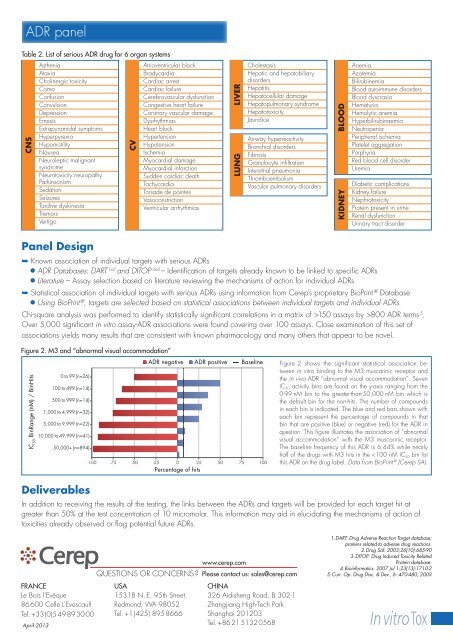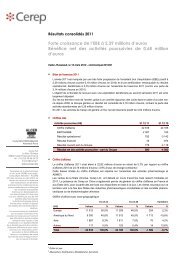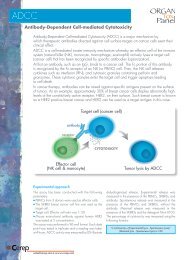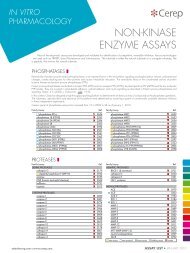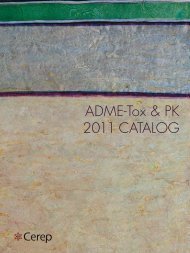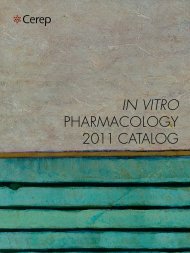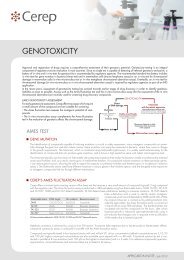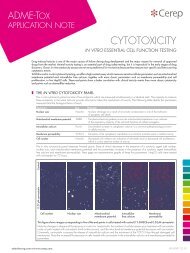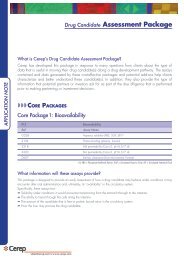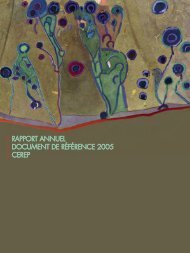In vitroTox - Cerep
In vitroTox - Cerep
In vitroTox - Cerep
You also want an ePaper? Increase the reach of your titles
YUMPU automatically turns print PDFs into web optimized ePapers that Google loves.
ADR panel<br />
Table 2. List of serious ADR drug for 6 organ systems<br />
CNS<br />
Asthenia<br />
Ataxia<br />
Cholinergic toxicity<br />
Coma<br />
Confusion<br />
Convulsion<br />
Depression<br />
Emesis<br />
Extrapyramidal symptoms<br />
Hyperpyrexia<br />
Hypomotility<br />
Nausea<br />
Neuroleptic malignant<br />
syndrome<br />
Neurotoxicity neuropathy<br />
Parkinsonism<br />
Sedation<br />
Seizures<br />
Tardive dyskinesia<br />
Tremors<br />
Vertigo<br />
CV<br />
Atrioventricular block<br />
Bradycardia<br />
Cardiac arrest<br />
Cardiac failure<br />
Cerebrovascular dysfunction<br />
Congestive heart failure<br />
Coronary vascular damage<br />
Dysrhythmias<br />
Heart block<br />
Hypertension<br />
Hypotension<br />
Ischemia<br />
Myocardial damage<br />
Myocardial infarction<br />
Sudden cardiac death<br />
Tachycardia<br />
Torsade de pointes<br />
Vasoconstriction<br />
Ventricular arrhythmias<br />
LIVER<br />
LUNG<br />
Cholestasis<br />
Hepatic and hepatobiliary<br />
disorders<br />
Hepatitis<br />
Hepatocellular damage<br />
Hepatopulmonary syndrome<br />
Hepatotoxicity<br />
Jaundice<br />
Airway hyperreactivity<br />
Bronchial disorders<br />
Fibrosis<br />
Granulocyte infiltration<br />
<strong>In</strong>terstitial pneumonia<br />
Thromboembolism<br />
Vascular pulmonary disorders<br />
BLOOD<br />
KIDNEY<br />
Anemia<br />
Azotemia<br />
Bilirubinemia<br />
Blood autoimmune disorders<br />
Blood dyscrasia<br />
Hematuria<br />
Hemolytic anemia<br />
Hyperbilirubinaemia<br />
Neutropenia<br />
Peripheral ischemia<br />
Platelet aggregation<br />
Porphyria<br />
Red blood cell disorder<br />
Uremia<br />
Diabetic complications<br />
Kidney failure<br />
Nephrotoxicity<br />
Protein present in urine<br />
Renal dysfunction<br />
Urinary tract disorder<br />
Panel Design<br />
➥ Known association of individual targets with serious ADRs<br />
l ADR Databases: DART 1&2 and DITOP 3&4 – Identification of targets already known to be linked to specific ADRs<br />
l Literature – Assay selection based on literature reviewing the mechanisms of action for individual ADRs<br />
➥ Statistical association of individual targets with serious ADRs using information from <strong>Cerep</strong>’s proprietary BioPrint ® Database<br />
l Using BioPrint ® , targets are selected based on statistical associations between individual targets and individual ADRs.<br />
Chi-square analysis was performed to identify statistically significant correlations in a matrix of >150 assays by >800 ADR terms 5 .<br />
Over 5,000 significant in vitro assay-ADR associations were found covering over 100 assays. Close examination of this set of<br />
associations yields many results that are consistent with known pharmacology and many others that appear to be novel.<br />
Figure 2. M3 and “abnormal visual accommodation”<br />
IC 50<br />
BinRange (nM) / BinHits<br />
ADR negative ADR positive Baseline<br />
0 to 99 (n=26)<br />
100 to 499 (n=14)<br />
500 to 999 (n=14)<br />
1,000 to 4,999 (n=32)<br />
5,000 to 9,999 (n=22)<br />
10,000 to 49,999 (n=41)<br />
50,000+ (n=894)<br />
-100 -75 -50 -25 0 25 50 75 100<br />
Percentage of hits<br />
Figure 2 shows the significant statistical association between<br />
in vitro binding to the M3 muscarinic receptor and<br />
the in vivo ADR “abnormal visual accommodation”. Seven<br />
IC 50 activity bins are found on the y-axis ranging from the<br />
0-99 nM bin to the greater-than-50,000 nM bin which is<br />
the default bin for the non-hits. The number of compounds<br />
in each bin is indicated. The blue and red bars shown with<br />
each bin represent the percentage of compounds in that<br />
bin that are positive (blue) or negative (red) for the ADR in<br />
question. This figure illustrates the association of “abnormal<br />
visual accommodation” with the M3 muscarinic receptor.<br />
The baseline frequency of this ADR is 6.44% while nearly<br />
half of the drugs with M3 hits in the


